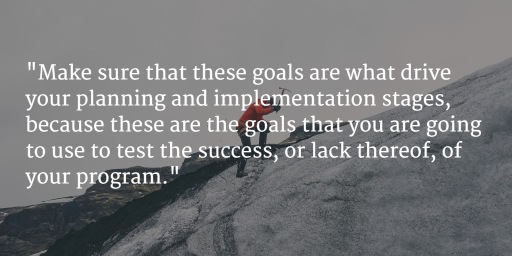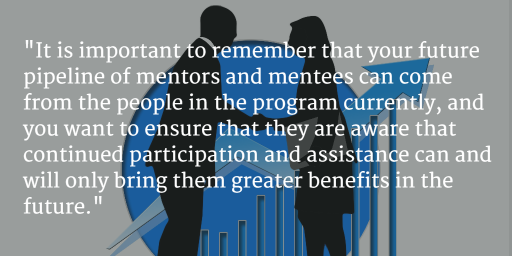The benefits of mentoring are threefold, for the mentee, the mentor and the organisation which structures and runs a supported mentoring program (you can find out more about the benefits here). With the virtues of mentoring being extolled as strong achievements in talent strategy, staff retention, leadership development and engagement, how do organisations ensure that their mentoring programs are structured and run according to their needs and that they are capable of achieving these lofty goals?
Step One: What Will Your Program Achieve?
It’s time to once again pull out those SMART (Specific, Measurable, Attainable, Realistic, Timed) goals and get specific – what exactly is your mentoring program trying to achieve? Are you focusing on your leadership pipeline or succession planning; do you require a program focused on high flyers to conduct talent management? Are you concerned with a lack of diversity in your organisation; do you want to provide mentors that can help minorities or women find a path to the C-suite and increase diversity at a senior management level? Are you interested in increasing technical know-how and understanding how to move from an understanding of Web 2.0 to Web 3.0; do you want to use reverse mentoring, or have mentoring which focuses on expanding the technical understanding of specific teams?
By creating measurable goals you might find that you require more than one program. Make sure that these goals are what drive your planning and implementation stages, because these are the goals that you are going to use to test the success, or lack thereof, of your program.
Step Two: Create a Structure
Before you can start matching staff and sitting back to watch the magic, there are policies and procedures that need to be in place before you can launch your program. Questions need to be asked such as:
- ‘How long will mentoring relationships in this program last?’ (many believe that 9 months to a year is the perfect lifespan),
- ‘What system will be used to match mentors with mentees?’
- ‘When and how often will we assess the partnership to ensure the relationship is hitting its goals?’
- ‘Will this be a rolling scheme or will it be run during specific times with new applications only taken after the end of the previous session?’
- ‘What happens when a matched pair are clearly a poor match and don’t work well together, or if one half of the pair leaves the organisation?’
- ‘How will we conduct diversity mentoring if we don’t have a suitable candidate to mentor the mentee?’
- ‘How is success going to be measured?’
- ‘How will mentoring take place? Will the organisation utilise 1-1, group, peer to peer, online, reverse mentoring or a combination of some or all of these methods?’
Once you have and understanding and the ground rules for how the program will run, it’s time to start looking at the mentoring sessions themselves; a balance needs to be struck between allowing the professional relationship to grow organically, and ensuring that the mentoring sessions achieve their objectives. Guidelines are often a good way to ensure positive behaviour and information on how to conduct the mentoring relationship (1). Similarly a mentoring contract might be utilised that sets out the terms of the relationship and what it hopes to achieve. A mentoring contract will usually include confidentiality clauses, logistical information including contact information and how often to meet, perhaps even when and where, the length of the relationship and how it will end, clauses on honesty of feedback and privacy boundaries to ensure a positive working relationship, how the mentee’s line manager will be involved and, importantly, what the goals are for the relationship. In heavily regulated industries, contracts may also include liability waivers and legal structure around the mentoring relationship (2).

A mentoring contract can help mentors and mentees to feel confident regarding the parameters of their professional relationship.
A formal application process will need to be undertaken to locate potential mentors and mentees. Ensure that this process includes information on what exactly is expected from participants so they can make an informed decision regarding the commitment required of them. The application form itself should include questions that will assist you with matching mentors to mentees. When selecting your participants, ensure that you only select those who are suited to the program you are running. Don’t be tempted to choose everyone to boost numbers; when running a mentoring program you should ensure that you are selecting the quality of effective relationships over the quantity of people participating.
Step Three: Train and then Launch
Before you launch your program, you need to ensure that participants understand how the mentoring experience should work. Without guidance, there is no way to ensure that mentoring goals will be achieved when participants are left to their own devices, so all participants require a clear understanding of expectations, roles and responsibilities.
Both mentors and mentees should be trained separately in the program’s policies and procedures and their specific obligations and roles within the relationship, any ethical or liability issues should also be covered at this stage. Focus should be placed on the expectations of the program and the goals they have signed on to work towards as participants in the program. Further to this, training should be provided in relationship development and maintenance, how to effectively close the relationship and what resources and assistance are available to support them.
You are now ready to launch your mentoring partnerships, don’t forget to check in and ensure that you are there for support if relationships and the mentoring experience don’t meet expectations for any reason.
Step Four: Assess and Tweak
When assessing a mentoring program it is important that you have as much useful, relevant data as you can generate. To produce solid qualitative data you should partner with and utilise the knowledge of the HR department to track metrics such as mentee absence and retention, advancement statistics, and engagement rates. For quantitative data, surveys and interviews should be undertaken with both mentors and mentees to gain a broader understanding of their experience with the program, how participants feel they personally benefited, how their partner benefitted, any roadblocks or difficulties which came up during the course of the program and any recommendations for areas to review and improve.
Once you have identified those areas that could be improved, make sure you communicate to present and past participants the ways in which you are working to refine and improve the program. It is important to remember that your future pipeline of mentors and mentees can come from the people in the program currently, and you want to ensure that they are aware that continued participation and assistance can and will only bring them greater benefits in the future.
Creating a mentoring program is a complex and difficult process, as any process involving human relationships can be, but once it is running effectively it can and does reap benefits for the people involved and their organisations.
- A good example of guidelines can be found here: https://ascept.org/wp-content/uploads/2013/07/Guidelines-ASCEPT-Mentoring-Program-2013.pdf
- An example of an outline of a technical, legal mentoring contract can be found here: mentorsme.co.uk/images/uploads2/mentoring_contract.doc




















